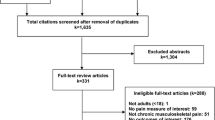Abstract
Standardized questionnaires offer a practical and cost-effective means for measuring moderate disability. Fourteen questionnaires that can be used for assessing pain-related disability are reviewed in this article. Their comparative attributes are summarized. Most of the questionnaires obtain information about specific activities of daily living. They vary in terms of structure, content, and intended applications. Psychometric theory provides the optimal method for evaluating these questionnaires, highlighting the importance of reliability and validity. Being mindful of psychometric qualities will help the evaluator to select an appropriate questionnaire. The present array of existing instruments points toward a need for comparison studies that may eventually result in more uniform methods for evaluating pain-related disability.
Similar content being viewed by others
References
Osterweis M, Kleinman A, Mechanic D.Pain and disability: Clinical, behavioral, and public policy perspectives. Washington: National Academy Press, 1987, p. 268.
Mayer TG, Tencer AF, Kristoferson MS, Mooney V. Use of noninvasive techniques for quantification of spinal range-of-motion in normal subjects and chronic low-back dysfunction subjects.Spine 1984; 5: 88–95.
Keefe FJ, Wilkins RH, Cook WA. Direct observation of pain behavior in low back pain patients during physical examination.Pain 1984; 20: 59–68.
Follick, MJ, Ahern DK, Aberger EW. Development of an audiovisual taxonomy of pain behavior: Reliability and discriminant validity.Health Psychol 1985; 4: 555–568.
Deyo RA. Measuring the functional status of patients with low back pain.Arch Phys Med Rehab 1988; 69: 1044–1053.
Anastasi, A.Psychological testing (3rd Ed.). New York: Macmillan, 1968, p. 7.
Waddell G, Main CJ. Assessment of severity in low-back disorders. Spine 1984; 9: 204–208.
Bergner, M, Bobbitt RA, Carter WB, Gilson, BS. The Sickness Impact Profile: Development and final revision of a health status measure.Med Care 1981; 19: 787–805.
Roland M, Morris R. A study of the natural history of back pain. Part I: Development of a reliable and sensitive measure of disability in low-back pain.Spine 1983; 8: 141–144.
Deyo RA. Comparative validity of Sickness Impact Profile and shorter scales for functional assessment in low-back pain.Spine 1986; 11: 951–954.
Millard RW, Jones RE. Construct validity of practical questionnaires for assessing disability of low-back pain.Spine 1991; 16: 835–838.
Lehmann TR, Brand RA, Gorman TW. A low-back rating scale.Spine 1983; 8: 308–315.
Million R, Hall W, Nilsen KH, Baker RD, Jayson MI. Assessment of the progress of the back pain patient.Spine 1982; 7: 204–212.
Fairbank JC, Couper J, Davies JB, O'Brien JP. The Oswestry low back pain disability questionnaire.Physiotherapy 1980; 66: 271–273.
Triano JJ, Schultz AB. Correlation of objective measure trunk motion and muscle function with low-back disability ratings.Spine 1987; 12: 561–565.
Hazzard RG, Fenwick JW, Kalisch SM, Redmond J, Reeves V, Reid S, Frymoyer JW. Functional restoration with behavioral support. A one-year prospective study of patients with chronic low-back pain.Spine 1989; 14: 157–161.
Kames LD, Naliboff BD, Heinrich RL, Schag CC. The Chronic Illness Problem Inventory: Problem-oriented psychosocial assessment of patients with chronic illness.Int J Psychiat Med 1984; 14: 65–75.
Evans JH, Kagan A. Development of a functional rating scale to measure treatment outcome of chronic spinal patients.Spine 1986; 11: 277–281.
Kerns RD, Turk DC, Rudy TE. The West Haven-Yale multidimensional pain inventory.Pain 1985; 23: 345–356.
Turk DC, Rudy TE, Stieg RL. The disability determination dilemma: Toward a multiaxial solution.Pain 1988; 34: 217–230.
Tait RC, Chibnall JT, Krause S. The Pain Disability Index: Psychometric properties.Pain 1990; 40: 171–182.
Rock DL, Fordyce WE, Brockway JA, Bergman JJ, Spengler DM. Measuring functional impairment associated with pain: Psychometric analysis of an exploratory scoring protocol for activity pattern indicators.Arch Phys Med Rehab 1984; 65: 295–300.
Millard RW. The Functional Assessment Screening Questionnaire: Application for evaluating pain-related disability.Arch Phys Med Rehab 1989; 70: 303–307.
Fries JF, Spitz PW, Young DY. The dimensions of health outcomes: The Health Assessment Questionnaire, Disability, and Pain Scales.J Rheumatol 1982; 9: 789–793.
Hawley DJ, Wolfe F, Cathey MA. Pain, functional disability, and psychological status: A 12-Month study of severity in fibromyalgia.J Rheumatol 1988; 15: 1551–1556.
Barnes, D., Benjamin S. The Self-Care Assessment Schedule (SCAS)-I. The purpose and construction of a new assessment of self care behaviours.J Psychosomat Res 1987; 31: 191–202.
Benjamin S, Barnes D. The Self-Care Assessment Schedule (SCAS)-II. Reliability and validity.J Psychosomat Res 1987; 31: 203–214.
Follick MJ, Smith TW, Ahern DK. The Sickness Impact Profile: A global measure of disability in chronic low back pain.Pain 1985; 21: 67–76.
Watt-Watson JH, Graydon JE. Sickness Impact Profile: A measure of dysfunction with chronic pain patients.J Pain Sympt Mnmt 1989: 4: 152–156.
Turner JA, Clancy S, McQuade KL, Cardenas DD. Effectiveness of behavioral therapy for chronic low back pain: A component analysis.J. Consult Clin Psychol 1990; 58: 573–579.
Author information
Authors and Affiliations
Rights and permissions
About this article
Cite this article
Millard, R.W. A critical review of questionnaires for assessing pain-related disability. J Occup Rehab 1, 289–302 (1991). https://doi.org/10.1007/BF01073694
Issue Date:
DOI: https://doi.org/10.1007/BF01073694




